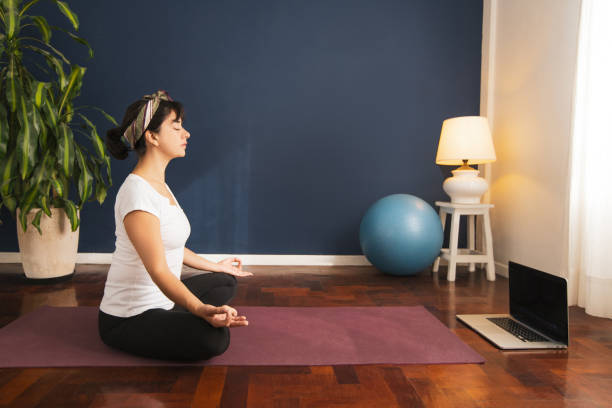What Is The Purpose Of The Mantra During Meditation? How To Use The Mantra?
Consider a mantra, which is a word or phrase repeated during meditation, as a tool to aid in mind-clearing. It can significantly alter your experience, particularly if you struggle with focus or mental clarity.
Many people discover that reciting a mantra can sharpen their focus and increase awareness. You might achieve better results from meditation because it keeps you focused.
Table of Contents
What Are Mantras?
The term mantra derives from Sanskrit, meaning “to elevate the mind” or “mind vehicle.”
Thoughts do not need to be stopped during mantra meditation. Instead, it is a verbalization that enables the meditate to slow their thoughts and turn inward.
Expanding mental awareness in order to observe thoughts and actions without participating is the aim of mindful meditation.
Mantra-based mindful meditation develops a state of present-moment awareness with practice. Being present enables one to experience the present with a greater level of awareness and without passing judgment.
What is the Purpose of the Mantra During Meditation
A Mantra Helps You Focus
When practicing meditation, the main goal of using a mantra is to help you focus your attention, which is admittedly not always simple, especially if you’re just starting out. You can eventually move toward higher levels of consciousness by taking control of your wandering thoughts.
During meditation, you would repeatedly say a mantra (typically aloud) while concentrating on the sound and/or vibration produced by the specific word, sound, or phrase that you have determined is best for you.
A Mantra Acts as a Subconscious Affirmation
When recited repeatedly, a mantra can serve as an affirmation and helps to rewire your subconscious mind with the message you’re trying to send.
You are in a deep state of relaxation while meditating, and your thoughts start to fade. In your subconscious mind, the message is anchored more firmly thanks to this.
You can create or use mantras that are related to the areas of your life where they are most necessary. For example, it could be something like “Love,” “Be open,” “I Am whole,” “I Am positive,” “I Am successful,” “I Am powerful,” or “I Am the conscious creator of my own reality,” etc.
Mantras Help Healing and Restoration
Vibrations and sound are also thought to have healing properties in many schools of meditation as well as other disciplines like yoga and reiki. These practices are accustomed to using ancient sound healing techniques, which involve using particular tonal frequencies to realign the body into a state of vibrational balance.
By opening and purifying your chakra systems, which are essentially your body’s energy centers, when you chant a mantra properly (for instance, chanting OM), the resonant sounds penetrate deeply into your body and aid in your return to a state of harmony and balance.
In order to help you heal and balance your chakras, there are specific mantras for each chakra.
Reinforcement of Meditation Goals
Many people who practice meditation think that the vibrations and harmony of chanting particular syllables can facilitate a deeper state of meditation. Any blocked energy disrupting your well-being can be released with the aid of this in-depth meditation.
You might choose a specific word or phrase that emphasizes your reasons for meditation, such as the Sanskrit word “shanti,” which means “peace.”
It can help to reinforce a sense of calm or joy to meditate while thinking of a word you like the sound of or that makes you happy.
Selecting affirming words and phrases directs your attention to your intentions. When you practice meditation and don’t experience any results, it can be discouraging. However, by repeatedly repeating a mantra that embodies the future you want for yourself, you can increase the likelihood that it will come to pass.

Improves Brain Function
Studies show that one of the simplest methods to change brain activity patterns is meditation. Mantra meditation may trigger brain changes that result in elevated mood and well-being, reduced fatigue, and enhanced verbal and spatial memory.
Additionally, the constant self-awareness or presentness that is a fundamental component of mantra mindfulness enables the practitioner to keep a safe distance from a personal experience.
Over time, this practice encourages self-regulated behaviors, enhances mental health, and promotes a healthy lifestyle.
Promotes Better Sleep
One sound or vibration during a guided meditation can replace 10,000 thoughts, allowing the mind to concentrate.
This deliberate effort results in inner peace and causes hypometabolic changes that cause the relaxation response to take place.
Promotes Creativity
Genius is often defined as “exceptional creative power.” Centering thoughts is among the most important advantages of mantra meditation.
We can increase our creativity by reducing the jitteriness of our thought processes. Our minds are capable of generating fresh concepts and making unexpected connections between seemingly unrelated ideas when they are relaxed.
Promotes Self-Awareness
Improved self-awareness is one of the advantages of mindfulness. By gently focusing on being present in this world and allowing for a deeper understanding of relationships, using a mantra during meditation can help to calm the mind.
When our thoughts and actions can be examined and released without feeling guilty or suffering the consequences, this is when being present creates a buff. This condition gradually promotes a more positive self-perception.
Calms Anxiety
Through the release of endorphins in the brain, mantra meditation has been shown in numerous studies to lessen fear and anxiety.
Along with reducing psychological stress-related anxiety and depression, it also reduces physical stress.
Better Control over Breath
Finding a natural breathing rhythm while meditating can also be aided by repeating a mantra.
It can take some time to get used to breathing exercises for meditation. You can streamline this process and feel more at ease at the same time by matching your breath to your mantra.
Choosing a Mantra
There is really no wrong approach when trying to find a mantra.
Some simple mantras are syllables or vowel sounds, such as the common “om” or “aum.” Though brief, this sound is incredibly potent. Many people believe that this sound is the source of the universe.
Another common meditation mantra is the Sanskrit “So Hum,” or “I am.”
Other types of mantras associated with more specific goals include:
• deity mantras
• healing mantras
• chakra mantras
Contact a nearby yoga studio or meditation center if you’d like more information on the significance of a particular mantra.
Why not include this in your mantra if you have a specific objective or intention for your meditation practice?
To feel calmer or relieve a low mood, for example, you might choose something like:
• “I am calm.”
• “My life is a joyous one.”
Even the words “calm,” “joy,” or “kindness” can serve as effective mantras, if you want to keep it short.

How to Use a Mantra to Meditate?
Get Comfortable
A quiet place where you can meditate without disruptions. Find a sitting, lying, or even walking position that you can maintain for the duration of your meditation. A meditative state can be reached without the use of mudras, or hand positions, according to some people.
Set a Timer
Decide how long you want to meditate (anywhere from 3 to 30 minutes) and set a timer. So that the alarm doesn’t wake you from a deep state of meditation, think about using a soothing sound like birdsong or the sound of the ocean.
Start With a Few Deep Breaths
Do not attempt to alter your breathing; simply pay attention to it. Just concentrate on the sensation as it fills your body and enters your lungs.
Use Your Mantra
As you begin chanting your mantra, keep breathing steadily and slowly through your nose. You can either repeat it silently or aloud (this may be more effective with mantras meant to cause vibrations). It frequently helps to time your mantra with your breathing.
Let Your Breath Guide You
Your mantra and breathing will eventually find a rhythm as you get comfortable with the meditation. If you follow this flow, your meditation may feel more natural—unless you’re trying to use a particular breathing technique.
Remember to Gently Redirect Wandering Thoughts
You’ll probably become aware of your attention wandering while you’re meditating. Do not attempt to push those unwanted thoughts away when this occurs. Simply acknowledge them, let them go, and then pick up the mantra once more.
Close the Meditation
Don’t immediately stand up when the timer goes off. Instead, spend some time sitting and letting your (hopefully) still mind wander. Self-reflect, please. Have you become more at ease? This final exercise allows you to reflect on yourself and monitor your development.
The Bottom Line
Most meditators have a purpose in mind, whether it be for self-care, relaxation, or developing compassion.
You can concentrate on what you want to achieve through meditation by selecting a mantra that expresses your objectives. By doing so, you can increase the advantages of meditation and strengthen your dedication to the practice.





